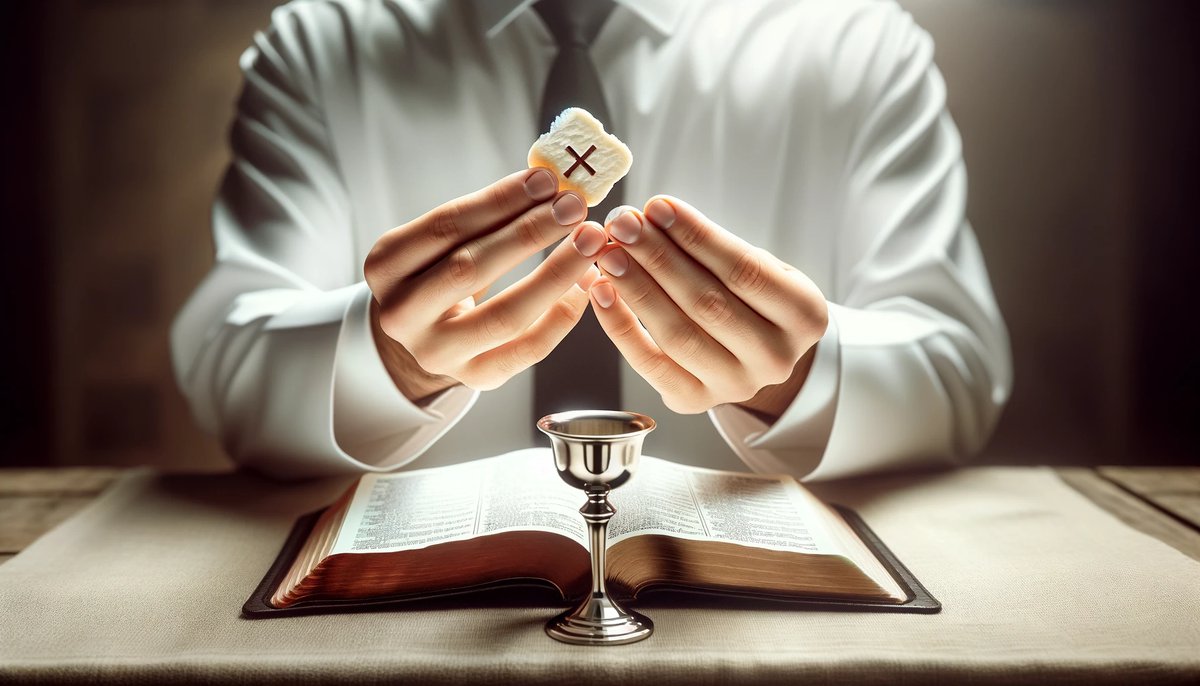Home>Theology and Spirituality>How Should The Communion Table Be Set Up


Theology and Spirituality
How Should The Communion Table Be Set Up
Published: February 24, 2024
Ericka Andersen, an editor at Christian.net, expertly merges digital strategy with content creation, focusing on faith and societal issues. Her communication skills enhance the platform's engaging narratives, fostering meaningful dialogue on belief's impact on society.
Discover the proper way to set up the communion table and create a meaningful experience for your congregation. Explore the theological and spiritual significance of communion.
(Many of the links in this article redirect to a specific reviewed product. Your purchase of these products through affiliate links helps to generate commission for Christian.net, at no extra cost. Learn more)
Table of Contents
Introduction
The communion table, also known as the Lord's table or the Eucharist, holds profound significance in Christian worship. It serves as a focal point for the sacred ritual of communion, where believers partake of bread and wine in remembrance of the sacrificial death and resurrection of Jesus Christ. The manner in which the communion table is set up reflects theological, historical, and practical considerations that vary across different Christian traditions.
The arrangement of the communion table is not merely a matter of aesthetics; rather, it embodies rich symbolism and spiritual significance. Understanding the historical background, symbolism, and practical considerations associated with the communion table's setup is essential for appreciating its role in the life of the church and the spiritual journey of believers.
As we delve into the historical roots and symbolic meanings of the communion table, we will gain a deeper understanding of its profound significance in Christian worship. Additionally, exploring the practical considerations and diverse traditions related to the communion table's setup will provide valuable insights into the various ways in which this sacred ritual is observed and honored within the global Christian community.
The communion table stands as a tangible representation of the unity of believers in Christ and the spiritual nourishment found in the body and blood of Jesus. It is a place of encounter with the living God, where the faithful are invited to partake in a sacred meal that transcends time and space, connecting them to the redemptive work of Christ and to one another as members of His body, the church.
In the subsequent sections, we will embark on a journey through the historical, symbolic, and practical dimensions of the communion table's setup, exploring the diverse traditions and practices that enrich the tapestry of Christian worship. Through this exploration, we will gain a deeper appreciation for the profound significance of the communion table and its role in fostering spiritual communion and unity among believers.
Read more: Why Should You Not Take Communion
Historical Background of Communion Table Set Up
The historical roots of the communion table's setup can be traced back to the early Christian church and the practices established by the apostles and early believers. In the New Testament, the accounts of the Last Supper, where Jesus instituted the sacrament of communion, provide foundational insights into the origins of this sacred ritual. The Gospel narratives of Matthew, Mark, and Luke, as well as the Apostle Paul's writings in the New Testament, offer glimpses into the early Christian observance of the Lord's Supper.
During the early centuries of Christianity, believers gathered in homes and communal settings to partake in the Eucharist, often as part of a shared meal known as the agape feast. The communion table, in its earliest form, was likely an ordinary table or surface around which the community assembled to celebrate the sacred meal instituted by Jesus. The emphasis was on fellowship, mutual sharing, and the remembrance of Christ's sacrificial death and resurrection.
As the Christian church evolved and formalized its worship practices, the communion table took on greater significance and began to be distinguished as a dedicated space for the celebration of the Eucharist. In the medieval period, the concept of the altar, a raised and consecrated table, became prominent within the liturgical traditions of Western Christianity. The altar, often adorned with elaborate decorations and symbols, served as the focal point for the celebration of the Mass and the reception of the Eucharist.
The Protestant Reformation brought about significant changes in the understanding and practice of communion, with various reformers advocating for a return to the simplicity and authenticity of early Christian worship. This movement led to diverse approaches to the communion table's setup, reflecting theological convictions and liturgical preferences within different Protestant traditions.
In contemporary Christian worship, the historical background of the communion table's setup is reflected in a spectrum of practices, ranging from the ornate altars of high church traditions to the unadorned tables of more minimalist congregations. The historical trajectory of the communion table's setup underscores the dynamic interplay between tradition, theology, and cultural context, shaping the diverse expressions of this central sacrament within the global Christian community.
Symbolism and Meaning of Communion Table Set Up
The communion table, with its arrangement and adornments, embodies profound symbolism and spiritual significance within Christian worship. Each element of its setup conveys layers of meaning that enrich the experience of partaking in the Eucharist and deepen the believers' connection to the redemptive work of Christ.
1. Table as a Symbol of Fellowship and Unity
The very act of setting up a table for communion reflects the biblical concept of fellowship and unity among believers. The table becomes a tangible representation of the shared spiritual journey and communal bond that unites the body of Christ. As believers gather around the communion table, they are reminded of their interconnectedness and the call to love and support one another as members of God's family.
2. Bread and Wine as Symbols of Christ's Body and Blood
The placement of the bread and wine on the communion table holds profound symbolism, representing the body and blood of Jesus Christ. These elements evoke the sacrificial act of Christ's crucifixion and the spiritual nourishment received through His redemptive work. The arrangement of the bread and wine on the table serves as a visual reminder of Christ's presence in the midst of the worshipping community.
Read more: When Should Holy Communion Be Taken
3. Decor and Adornments as Symbols of Reverence and Holiness
The manner in which the communion table is adorned and decorated reflects the reverence and holiness attributed to the sacrament of communion. Whether adorned with a simple cloth or elaborate liturgical paraments, the decor signifies the sacred nature of the Eucharist and the solemnity with which it is approached. The use of candles, crosses, or other symbolic items further enhances the visual representation of the table as a sacred space set apart for encountering the divine.
4. Positioning as a Symbol of Christ's Presence
The positioning of the communion table within the worship space carries symbolic significance, often emphasizing the centrality of Christ's presence in the life of the church. Whether placed at the front and center of the sanctuary or within a designated chapel, the table's location serves as a focal point for directing the congregation's attention to the spiritual significance of the Eucharist and the ongoing presence of Christ among His people.
5. Open or Closed Communion as a Symbol of Inclusivity or Doctrinal Adherence
The practice of open or closed communion, reflected in the setup of the communion table, symbolizes the church's stance on inclusivity and doctrinal adherence. An open table signifies a welcoming invitation for all believers to partake in the Eucharist, emphasizing the universal grace of God. In contrast, a closed table may reflect doctrinal considerations and the need for spiritual discernment in partaking of the sacrament.
In essence, the communion table's setup serves as a visual and symbolic expression of the central tenets of Christian faith, encapsulating themes of fellowship, redemption, reverence, and Christ's abiding presence. Its arrangement and adornments create a sacred space where believers are invited to encounter the living Christ and participate in the ongoing narrative of God's redemptive love for humanity.
Practical Considerations for Setting Up the Communion Table
When preparing the communion table, several practical considerations come into play, encompassing both logistical and theological aspects. These considerations are essential for ensuring that the setup aligns with the sacred nature of the Eucharist and facilitates a meaningful experience for the worshipping community.
1. Table Arrangement and Accessibility
The physical arrangement of the communion table within the worship space is a crucial practical consideration. It should be positioned in a manner that allows for easy access and visibility for the congregation. Placing the table at the front and center of the sanctuary or within a designated area ensures that it becomes a focal point for the entire worshipping community, emphasizing the centrality of the Eucharist in the worship service.
2. Adornments and Decor
The choice of adornments and decor for the communion table should be intentional, reflecting the reverence and solemnity of the sacrament. Whether using a simple linen cloth or elaborate liturgical paraments, the decor should enhance the sense of sacredness surrounding the table. Additionally, the inclusion of symbolic items such as candles, crosses, or seasonal decorations can further enrich the visual representation of the table as a sacred space set apart for communion.
3. Elements of the Eucharist
The placement of the bread and wine, the central elements of the Eucharist, requires careful consideration. These elements should be positioned in a manner that allows for easy distribution during the communion service. Practical aspects such as the size and shape of the vessels, as well as the logistics of serving the congregation, play a significant role in determining the setup of the bread and wine on the table.
4. Inclusivity and Accessibility
In contemporary Christian worship, considerations of inclusivity and accessibility are paramount in setting up the communion table. Churches may deliberate on whether to practice open or closed communion, reflecting their stance on welcoming all believers to partake in the Eucharist or adhering to specific doctrinal guidelines. This practical consideration influences the manner in which the communion table is prepared and the message it conveys to the worshipping community.
Read more: When Should Catholics Kneel After Communion
5. Liturgical Season and Themes
The liturgical season and thematic emphasis of the worship service often inform the practical setup of the communion table. Churches may incorporate seasonal colors, symbols, or thematic elements into the table arrangement to align with the broader worship context. This intentional integration of the communion table with the liturgical themes enhances the cohesive flow of the worship experience.
In essence, the practical considerations for setting up the communion table encompass a thoughtful blend of logistics, aesthetics, and theological significance. By attending to these considerations, churches can create a conducive environment for the celebration of the Eucharist, ensuring that the communion table serves as a focal point for encountering the living Christ and fostering spiritual communion among believers.
Different Traditions and Practices for Communion Table Set Up
The setup of the communion table varies significantly across different Christian traditions, reflecting diverse theological perspectives, liturgical practices, and cultural influences. These variations in the arrangement and adornment of the communion table contribute to the rich tapestry of worship expressions within the global Christian community.
High Church Traditions
Within high church traditions, such as Roman Catholicism, Eastern Orthodoxy, and Anglicanism, the communion table, known as the altar, holds a central and elevated position within the sanctuary. The altar is often adorned with ornate paraments, candles, and religious imagery, symbolizing the sacredness of the Eucharist and the transcendent presence of Christ. The arrangement of the altar reflects a deep sense of reverence and continuity with historical liturgical practices, emphasizing the sacrificial nature of the Mass and the real presence of Christ in the Eucharistic elements.
Protestant Liturgical Traditions
In certain Protestant denominations with a strong liturgical emphasis, such as Lutheranism and some branches of Methodism, the communion table is often positioned prominently at the front of the sanctuary. It may be adorned with liturgical paraments and seasonal decorations, aligning with the liturgical calendar and thematic emphases of the worship service. The setup of the communion table in these traditions underscores a balance between reverence for the Eucharist and a simplified aesthetic that reflects the Protestant emphasis on the priesthood of all believers and the centrality of Scripture.
Read more: How Should A Baptist Church Choose A Deacon
Free Church and Non-Liturgical Traditions
In contrast, many free church and non-liturgical traditions, including various evangelical and charismatic congregations, adopt a more minimalist approach to the communion table setup. The table, often referred to as the Lord's table, is typically devoid of elaborate adornments and is situated in a less formal manner within the worship space. The emphasis is placed on the symbolic significance of the bread and wine, with a focus on the spiritual meaning of the Eucharist rather than ornate ritualistic elements.
Open and Inclusive Practices
Some Christian communities practice open communion, where all baptized believers, regardless of denominational affiliation, are invited to partake in the Eucharist. The setup of the communion table in these contexts reflects a welcoming and inclusive approach, often symbolizing the universal grace of God and the unity of the body of Christ across denominational boundaries. In contrast, churches practicing closed communion may adopt a more doctrinally specific setup, emphasizing the need for spiritual discernment and adherence to particular theological convictions in partaking of the sacrament.
Contemporary Innovations
In contemporary worship settings, there is a growing trend of incorporating innovative and culturally relevant elements into the communion table setup. This may include the use of multimedia, interactive displays, or artistic expressions that seek to engage worshippers in a multi-sensory experience of the Eucharist. Such innovations reflect a desire to bridge ancient traditions with contemporary expressions of faith, creating dynamic and immersive encounters with the sacred meal.
The diverse traditions and practices for communion table setup exemplify the breadth and depth of Christian worship, showcasing the multifaceted ways in which believers engage with the sacrament of communion. These variations not only reflect theological distinctives and historical legacies but also underscore the dynamic and evolving nature of Christian worship as it intersects with cultural, contextual, and spiritual dynamics.
Conclusion
The communion table, with its rich historical roots, profound symbolism, practical considerations, and diverse traditions, stands as a focal point of Christian worship, embodying the spiritual journey of believers and the redemptive narrative of Christ. As we conclude this exploration of the communion table's setup, it becomes evident that this sacred space serves as a tangible expression of the unity, reverence, and inclusivity inherent in the Eucharistic celebration.
The historical background of the communion table's setup, rooted in the early Christian church and shaped by the evolution of worship practices, underscores the dynamic interplay between tradition, theology, and cultural context. From the simplicity of early communal gatherings to the ornate altars of medieval liturgical traditions, the communion table's historical trajectory reflects the diverse expressions of Christian worship across centuries and continents.
Delving into the symbolism and meaning of the communion table's setup reveals its multifaceted significance as a symbol of fellowship, Christ's presence, and the sacredness of the Eucharist. Each element of its arrangement, from the placement of bread and wine to the choice of adornments, serves to deepen the believers' connection to the redemptive work of Christ and foster a sense of spiritual communion within the worshipping community.
The practical considerations for setting up the communion table highlight the intersection of logistics, aesthetics, and theological significance, emphasizing the need for intentional preparation that aligns with the sacred nature of the Eucharist. Whether addressing table arrangement, decor, elements of the Eucharist, inclusivity, or liturgical themes, these considerations contribute to creating a conducive environment for encountering the living Christ in the Eucharistic celebration.
Furthermore, the diverse traditions and practices for communion table setup exemplify the breadth and depth of Christian worship, showcasing the multifaceted ways in which believers engage with the sacrament of communion. Whether within high church traditions, Protestant liturgical contexts, free church and non-liturgical settings, or contemporary innovations, the communion table reflects the dynamic and evolving nature of Christian worship, embracing theological distinctives and cultural dynamics.
In essence, the communion table's setup transcends mere physical arrangement; it encapsulates the spiritual journey of believers, the redemptive narrative of Christ, and the diverse expressions of Christian worship. It stands as a sacred space where the faithful are invited to partake in a timeless ritual that unites them with the living Christ and with one another, fostering spiritual communion and unity within the body of Christ.











